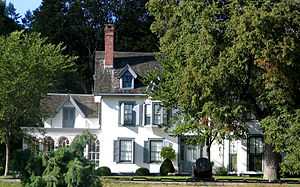Robert Erskine

Colonel Robert Erskine (1735 – 1780) was a Scottish inventor and later an American officer in the Continental Army during the American Revolutionary War.[1]
Born in Scotland, Erskine was an inventor and engineer of some renown in his native land. He attended the University of Edinburgh and started a failed business in his youth. He invented the "Continual Stream Pump" and "Platometer", a centrifugal hydraulic engine, and experimented with other hydraulic systems. He became active in civic issues and increasingly gained the respect of his community. In 1771, he was elected a Fellow of the Royal Society, a prestigious appointment in the scientific community.
In 1771, the owners of the ironworks near Ringwood, New Jersey, tapped Erskine to replace Peter Hasenclever as iromaster after Hasenclever's profligate spending nearly bankrupted the operation.
Erskine immediately set about trying to make the operation profitable. His efforts were cut short by the American Revolutionary War. Erskine was sympathetic to the American cause, but worried that might he lose his workers to the army. He organized them into a militia and was appointed a militia captain in August 1775.
Once the war broke out in earnest, there was concern among the rebels that the British warships would use the Hudson river to attack northern forts and separate New England from the rest of the colonies. Erskine, ever the engineer, designed a tetrahedron-shaped marine Chevaux-de-Frise -- essentially a barrier that would keep warships from moving upriver.
George Washington was impressed with Erskine from the moment they met and appointed him to the post of Geographer and Surveyor General of the Continental Army in 1777. Following his appointment, Erskine drew upwards of 275 maps covering the northern sector of the war. His maps of the region, showing roads, buildings, and other details, were of much use to Gen. Washington and remain historically valuable today. Many of these maps can be found in the Erskine Dewitt Map Collection at the New York Historical Society.[1][2]
Erskine also kept the ironworks in operation supplying critical munitions and materials to Washington's army.
While out on a map making expedition, Erskine contracted a cold and died on October 2, 1780, probably of pneumonia. He is buried at Ringwood Manor in Ringwood State Park in New Jersey.
Erskine Lake, as well as Robert Erskine Elementary School, both in Ringwood, New Jersey, are named after him.
Publications
- Erskine, Robert. Robert Erskine correspondence. n.d. Library of Congress.
- Erskine, Robert, and Nathanael Greene. [Map of Orange and Rockland Counties Area of New York]. 1779. Copied from surveys laid down by R. Erskine, F.R.S. 1778, 1779.
- Erskine, Robert. Lower Half of an Original Survey Done for His Excy. General Washington. Bergen: Bergen Historical Society, 1920. Printed facsimile of original map in the New-York Historical Society in which the place names have been written over for greater clarity. Shows topography, towns, and roads of northern New Jersey. by Robt. Erskine, f.r.s., geographer to the army, 1778-1779.
- Erskine, Robert. Litchfield, Conn., to the Highlands of Neversink. Washington: U.S. Army, Corps of Engineers, 1975. Facsimile. Robt. Erskine, F.R.S., Decr. 1779.
- Erskine, Robert, Simeon De Witt, and Richard Varrick De Witt. A List of the Rough Draughts of Surveys by Robert Erskine F.R.S. Geogr. A.U.S. and Assistants, Begun A.D. 1778. 1778. Index to 129 military topographic map titles which in turn describe a series of approximately 341 separate map sheets. (At least 283 of those sheets still exist; an additional dozen sheets appear to be related but are not indexed.) In its farthest conception, the index describes territory bounded by the Detroit River in the west, Lake Champlain in the north, the Connecticut River in the east and Charlestown, South Carolina in the south. However, most entries refer to western Connecticut, southeastern New York, northern New Jersey and eastern Pennsylvania. Entries through number 114 are in Erskine's hand. Subsequent entries probably by DeWitt, although nos. 115 and 116 have been attributed to Washington by Guthorn.
- Erskine, Robert, Simeon De Witt, Benjamin Lodge, and Richard Varrick De Witt. Mensurations on the Ice: Feby 7th 1780. 1780. Military topographic map. Covers the counties of Rockland and Westchester in New York. Shows dimensions of that widening of the Hudson River called "Haverstraw Bay." Also shows some roads. Includes text: "Measured on the Ice Feby. 7th Monday 1780 by [????] De[Witt] & Lodge" Both these men served under Erskine. Pen-and-ink, pencil on laid paper.
- Stephen A. Estrin, inc, and Robert Erskine. Westchester Heritage Map: Indian Occupation, Colonial and Revolutionary Names, Structures, and Events. [Tarrytown, N.Y.]: Junior League of Westchester-on-Hudson, 1978. Roads originally surveyed by Robert Erskine 1778-1780 ; Westchester heritage map prepared in 1977, 1978, by Stephen A. Estrin, inc., Carmel, N.Y., from Map of Westchester County showing Indian occupation, compiled by Westchester Historical Society with workers from the Emergency Work Bureau of Westchester County, dated 1933, and data supplied by the Westchester Heritage Task Force.
- Partridge, Edward Laselle, and Robert Erskine. Plan for Creation of a National Preserve ... Commemorative of the War of the American Revolution, and for the Preservation of the Natural Beauty of the Hudson River and of the Highlands of the Hudson. 1904. The map is a facsimile of surveys done for General Washington by Robert Erskine in 1778/79.
References
- ↑ 1.0 1.1 "Department of the Geographer to the Army, 1777-1783". Retrieved 2010-11-07.
- ↑ "New York Historical Society". Retrieved 2010-11-07.
External links
- Professional Surveyor Archives: Robert Erskine, Part I
- Professional Surveyor Archives: Robert Erskine, Part II
- Witness to the Early American Experience Contains digital copies of many of Robert Erskine's maps.
|